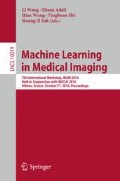Abstract
For neuroimaging-based brain disease diagnosis, sparse regression models have proved their effectiveness in handling high-dimensional data but with a small number of samples. In this paper, we propose a novel framework that utilizes sparse regression models as target-level representation learner and builds a deep convolutional neural network for clinical decision making. Specifically, we first train multiple sparse regression models, each of which has different values of a regularization control parameter, and use the outputs of the trained regression models as target-level representations. Note that sparse regression models trained with different values of a regularization control parameter potentially select different sets of features from the original ones, thereby they have different powers to predict the response values, i.e., a clinical label and clinical scores in our work. We then construct a deep convolutional neural network by taking the target-level representations as input. Our deep network learns to optimally fuse the predicted response variables, i.e., target-level representations, from the same sparse response model(s) and also those from the neighboring sparse response models. To our best knowledge, this is the first work that systematically integrates sparse regression models with deep neural network. In our experiments with ADNI cohort, we validated the effectiveness of the proposed method by achieving the highest classification accuracies in three different tasks of Alzheimer’s disease and mild cognitive impairment identification.
Access this chapter
Tax calculation will be finalised at checkout
Purchases are for personal use only
Notes
- 1.
We use a class indicator vector with zero-one encoding.
- 2.
A target-level representation map from multiple sparse regression models becomes \(\mathbf{v}_{1}^{0}\).
- 3.
Available at ‘http://www.vlfeat.org/matconvnet/’.
- 4.
For sparse model training, we used a SLEP toolbox, where it is required for the control parameter to be set between 0 and 1 because its value is internally rescaled [5].
References
Cotter, A., Shamir, O., Srebro, N., Sridharan, K.: Better mini-batch algorithms via accelerated gradient methods. In: Advances in Neural Information Processing Systems, vol. 24, pp. 1647–1655 (2011)
Davatzikos, C., Genc, A., Xu, D., Resnick, S.M.: Voxel-based morphometry using the RAVENS maps: methods and validation using simulated longitudinal atrophy. NeuroImage 14(6), 1361–1369 (2001)
Ioffe, S., Szegedy, C.: Batch normalization: accelerating deep network training by reducing internal covariate shift. In: Proceedings of the 32nd International Conference on Machine Learning, pp. 448–456 (2015)
Kabani, N., MacDonald, D., Holmes, C., Evans, A.: A 3D atlas of the human brain. NeuroImage 7(4), S717 (1998)
Liu, J., Ji, S., Ye, J.: SLEP: Sparse Learning with Efficient Projections. Arizona State University (2009)
Nair, V., Hinton, G.E.: Rectified linear units improve restricted Boltzmann machines. In: Proceedings of the 27th International Conference on Machine Learning, pp. 807–814 (2010)
Rumelhart, D.E., Hinton, G.E., Williams, R.J.: Learning representations by back-propagating errors. Nature 323(6088), 533–536 (1986)
Sled, J.G., Zijdenbos, A.P., Evans, A.C.: A nonparametric method for automatic correction of intensity nonuniformity in MRI data. IEEE Trans. Med. Imaging 17(1), 87–97 (1998)
Srivastava, N., Hinton, G., Krizhevsky, A., Sutskever, I., Salakhutdinov, R.: Dropout: a simple way to prevent neural networks from overfitting. J. Mach. Learn. Res. 15, 1929–1958 (2014)
Suk, H.I., Lee, S.W., Shen, D.: Deep sparse multi-task learning for feature selection in Alzheimer’s disease diagnosis. Brain Struct. Funct. 221(5), 2569–2587 (2016)
Suk, H.I., Shen, D.: Subclass-based multi-task learning for Alzheimer’s disease diagnosis. Front. Aging Neurosci. 6, 168 (2014)
Wang, H., Nie, F., Huang, H., Risacher, S., Saykin, A.J., Shen, L.: Identifying AD-sensitive and cognition-relevant imaging biomarkers via joint classification and regression. In: Fichtinger, G., Martel, A., Peters, T. (eds.) MICCAI 2011. LNCS, vol. 6893, pp. 115–123. Springer, Heidelberg (2011). doi:10.1007/978-3-642-23626-6_15
Yuan, L., Wang, Y., Thompson, P.M., Narayan, V.A., Ye, J.: Multi-source feature learning for joint analysis of incomplete multiple heterogeneous neuroimaging data. NeuroImage 61(3), 622–632 (2012)
Zhang, D., Shen, D.: Multi-modal multi-task learning for joint prediction of multiple regression and classification variables in Alzheimer’s disease. NeuroImage 59(2), 895–907 (2012)
Zhou, J., Liu, J., Narayan, V.A., Ye, J.: Modeling disease progression via fused sparse group lasso. In: Proceedings of the 18th ACM SIGKDD International Conference on Knowledge Discovery and Data Mining, pp. 1095–1103 (2012)
Acknowledgement
This research was supported by Basic Science Research Program through the National Research Foundation of Korea (NRF) funded by the Ministry of Education (NRF-2015R1C1A1A01052216) and also partially supported by Institute for Information & communications Technology Promotion (IITP) grant funded by the Korea government (MSIP) (No. B0101-15-0307, Basic Software Research in Human-level Lifelong Machine Learning (Machine Learning Center)).
Author information
Authors and Affiliations
Corresponding author
Editor information
Editors and Affiliations
Rights and permissions
Copyright information
© 2016 Springer International Publishing AG
About this paper
Cite this paper
Suk, HI., Shen, D. (2016). Deep Ensemble Sparse Regression Network for Alzheimer’s Disease Diagnosis. In: Wang, L., Adeli, E., Wang, Q., Shi, Y., Suk, HI. (eds) Machine Learning in Medical Imaging. MLMI 2016. Lecture Notes in Computer Science(), vol 10019. Springer, Cham. https://doi.org/10.1007/978-3-319-47157-0_14
Download citation
DOI: https://doi.org/10.1007/978-3-319-47157-0_14
Published:
Publisher Name: Springer, Cham
Print ISBN: 978-3-319-47156-3
Online ISBN: 978-3-319-47157-0
eBook Packages: Computer ScienceComputer Science (R0)

